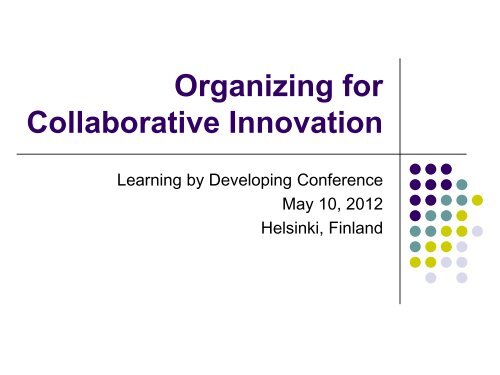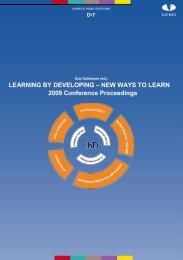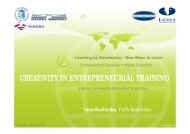Presentation slides - LbD Conference
Presentation slides - LbD Conference
Presentation slides - LbD Conference
Create successful ePaper yourself
Turn your PDF publications into a flip-book with our unique Google optimized e-Paper software.
Organizing for<br />
Collaborative Innovation<br />
Learning by Developing <strong>Conference</strong><br />
May 10, 2012<br />
Helsinki, Finland
My Current Activities<br />
Fulbright-Hall Chair in Entrepreneurship, Vienna University<br />
of Economics and Business<br />
Founding Member, Organizational Design Community<br />
(www.orgdesigncomm.com)<br />
Co-Editor, Journal of Organization Design<br />
(www.jorgdesign.net)
When The Innovation Process<br />
Is “Closed”<br />
Hold Creativity/Innovation Workshops<br />
Organize Innovation Tournaments<br />
Expand and/or Focus R&D<br />
Create Internal Venture Capital Committees<br />
Appoint and Empower Business Development<br />
Teams<br />
Acquire Other Firms
Individual Innovators: Nature<br />
or Nurture?<br />
According to J. Dyer, H. Gregersen, & C.M. Christensen, The<br />
Innovator’s DNA: Mastering the Five Skills of Disruptive<br />
Innovators:<br />
Associating – making connections across seemingly unrelated<br />
questions, problems, or ideas<br />
Questioning – a passion for inquiry<br />
Observing – carefully watch customers, technologies, firms, etc.<br />
Networking – find and test ideas through a diverse network of<br />
individuals<br />
Experimenting – try out new experiences and ideas
If You Have a Problem, Ask Everyone!<br />
-- Title of a New York Times article (Dean, 2008)
InnoCentive<br />
• Spun out of Eli Lilly in 2001<br />
• First online marketplace for corporate R&D<br />
• Seekers, Challenges, and Solvers<br />
• Process: Seekers formulate and post challenges. Registered<br />
solvers work on the challenges. Winning solvers get<br />
predetermined financial awards ($5,000 to $1 mil.)<br />
• InnoCentive has various programs that can be used for<br />
innovation, and it has mechanisms for protecting intellectual<br />
property rights.
P&G’s Connect and Develop<br />
Program<br />
• From R&D to C&D (from closed to open)<br />
• 7,500 internal R&D staff could be “connected” with 1.5 million<br />
people of similar or greater talent<br />
• Goal of 50% of innovations coming from outside the company<br />
• Technology briefs are provided to networks of: government and<br />
private labs, academic and other research institutions, suppliers,<br />
retailers, competitors, development and trade partners, VC firms,<br />
and individual entrepreneurs<br />
• 70 P&G “technology entrepreneurs” who work out of six C&D hubs<br />
in China, India, Japan, Western Europe, Latin America, and the U.S.
User-Driven Innovation<br />
• Identify “lead users” (customers who are at the front of<br />
market trends and who expect benefits from new<br />
products)<br />
• Use lead users to help develop new products and as<br />
beta sites<br />
• Establish programs that enable lead users to become<br />
entrepreneurs (e.g., LEGO‟s Ambassador Program,<br />
LEGO Architecture, LEGO Factory)
Knowledge-Intensive Sectors<br />
In industries in which knowledge is complex and widely<br />
distributed, the locus of innovation is beyond the firm.<br />
(Powell et al., 1996)<br />
Biotechnology<br />
Computers<br />
Micro-Electronics<br />
Professional Services
OpWin Global Network: Organized for<br />
Continuous Innovation<br />
• Three founding firms<br />
• Principal Office<br />
• Innovation Catalogue (Idea Bank)<br />
• 60 member firms collaborate with whomever<br />
they want
Blade.org: A Collaborative<br />
Community of Firms<br />
• Launched by IBM and seven other Founding Firms in<br />
2006<br />
• Capitalized on IBM‟s reputation forged in the open<br />
source software „movement‟<br />
• Grew to more than 200 member firms (mostly U.S. firms<br />
but some international)<br />
• Blade.org has a significant share of the blade-based<br />
computer server market<br />
• Blade.org ceased operations in June 2011
Blade.org: Strategy and<br />
Organization<br />
• Purpose is to find applications for IBM‟s bladecenter<br />
technology (a computer server technology)<br />
• Strategy is to invent new solutions via collaborative<br />
innovation projects and networks<br />
• Member firms are free to self-organize<br />
• Website, IdeaBank, and nine technical committees<br />
constitute the “commons”<br />
• Principal Office serves as the Shared Services Provider
Collaborative Processes at<br />
Blade.org<br />
Within 18 months, Blade.org firms developed more than<br />
60 solutions through:<br />
• Bilateral Collaboration (with customers)<br />
• Direct Collaboration (among two or more Blade.org<br />
member firms)<br />
• Pooled Collaboration (IdeaBank)<br />
• External Collaboration (with outside firms)
Actor-Oriented Architectural<br />
Scheme<br />
Actors who have the values and capabilities to<br />
self-organize<br />
Commons where resources are accumulated<br />
and shared<br />
Protocols, Processes, and Infrastructures that<br />
enable the actors to connect and collaborate
Conclusion<br />
Making a rich set of resources available to a<br />
large set of actors on an unlimited set of<br />
projects<br />
Yochai Benkler (2002)




